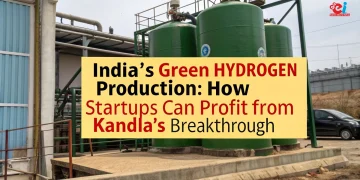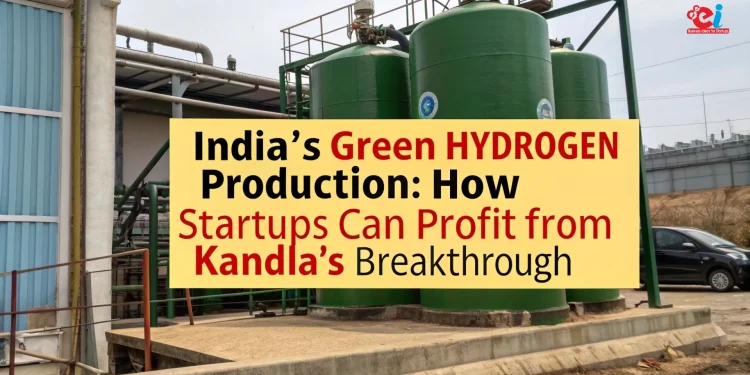As countries race to cut greenhouse gases, a new star is speeding to the front: green hydrogen. Instead of being something discussed only in labs, it is now an everyday reality—and in India, the transition is speeding up. Just a few weeks ago, the Deendayal Port Authority powered up India’s very first homegrown green hydrogen production facility in Kandla. This milestone isn’t only a proud engineering win; it is also a loud, clear message to every entrepreneur and startup: a new age of industry is here, packed with chances for fresh ideas, new factories, and real business success.
Until now, most hydrogen has come from processes that burn natural gas and release carbon. Green hydrogen flips that story completely. Using wind, solar, and hydropower, a simple, electrolytic process splits seawater or treated freshwater into hydrogen and oxygen, producing a chemical fuel that leaves the planet cleaner.
In this article, we will explore the dramatic changes this cleaner hydrogen brings, and we will sketch a practical guide for every new business that wants to thrive in the coming hydrogen marketplace. Expect forecasts of future demand, a rundown of the manufacturing steps, and smart tactics for building a company that is not only profitable but also a leader in India’s green hydrogen mission.
The Kandla Plant: A Bright New Opportunity for Business
The Kandla initiative is more than just another facility on the map; it is a beacon for anyone thinking about the future of clean energy in India. Built right here in the country, this plant is showcasing how India can roll out green hydrogen technology without needing to bring in outside hardware or talent. For a new business owner, this is an unmistakable signal to jump into a market where government support is strong and the homegrown know-how is even stronger.
This project is moving clean hydrogen efforts from small test sites to fully functioning, commercial-scale. That means an entire support economy is kicking into high gear. You will see demand for anyone who can build parts for electrolyzers, tanks that safely store hydrogen, or even firms that know the ins and outs of hydrogen transport and safety.
When publications like Chemical Weekly spotlight these pioneering efforts, it not only confirms the trend but also hands out a unique opportunity map for anyone keeping an eye on tomorrow.
Related: Sustainable Aviation Fuel: The Next Billion-Dollar Green Venture
Market Dynamics: A Tsunami of Growth
The worldwide green hydrogen market is surging upward, powered by countries setting aggressive decarbonization targets and businesses pledging to lower their carbon footprints. India, in particular, wants to cement its spot as a green hydrogen powerhouse. The National Green Hydrogen Mission lays out a roadmap to achieve energy independence and position the country as a vital contributor to the global clean energy shift.
Such a roadmap creates a market bursting with promise. The appetite for green hydrogen is estimated to emerge from several vital sectors:
- Refineries and Fertilizers: These facilities mostly rely on “grey” hydrogen made from natural gas. Shifting to green hydrogen is a central part of their plan to cut emissions.
- Mobility: The transport sector is still heavily dependent on fossil fuels. Hydrogen fuel cells are regarded as a workable option for heavy-duty trucks, buses, and even some shipping routes. They allow for quick refueling and offer an impressive driving range.
- Steel and Cement: Both sectors typically pose a challenge for decarbonization. Green hydrogen can replace coke and other fossil fuels during production, making the manufacturing process much cleaner and more sustainable.

Energy Storage Insight and Market Opportunity
Green hydrogen is gaining traction as a long-duration energy storage solution. Unlike batteries that last days or weeks, hydrogen can be stored for months without significant losses, smoothly bridging the gaps left by solar or wind fluctuations.
As this flexible storage capability becomes vital, the expected hydrogen market growth is staggering: analysts anticipate demand could climb at a compound annual growth rate (CAGR) above 20% for the next ten years. That rapid expansion leaves plenty of room for nimble tech startups to step in, innovate, and stake their claims early.
Related: Sustainability Business Practices: Why Going Green is the Future
How Green Hydrogen is Made
Startups exploring this field can’t skip the tech. Green hydrogen production begins with something as simple and abundant as water and transforms it into a versatile fuel using three integrated steps. Entrepreneurs can see the process as a triangle of renewable energy, water, and advanced engineering.
- Power from Renewables
Everything kicks off at a solar or wind facility. Its clean, carbon-free electricity is the lifeblood of the entire hydrogen facility. - Splitting the Water
That renewable power next travels to an electrolyzer. This innovative device breaks water (H₂O) into hydrogen (H₂) and oxygen (O₂). Inside the electrolyzer, a high-tech structure includes an anode on one side, a cathode on the other, and an electrolyte sandwiched in between. When the electricity flows, oxygen bubbles to the anode side, while hydrogen collects at the cathode side, ready for storage or further use. - Wrap It Up
The last step involves compressing, cooling, or liquefying that hydrogen for transport to pipelines, refueling stations, or storage tanks, making it a compact, storable energy asset.
Hydrogen Purification and Compression
The green hydrogen production you produced first gets purified. Any remaining water and oxygen are filtered out. Next, the gas is compressed. This is a must-do step. Compression shrinks the gas, so it’s easier to cram into a tank, move in a pipeline, or tow on a trailer.
Storage and Distribution
The purified, compressed hydrogen moves into high-pressure storage tanks. You can ship it out via a pipeline, load it onto a trailer, or change it into liquid hydrogen or ammonia. Both liquids can travel farther without needing gigantic tanks, and both can turn back into low-carbon hydrogen when their final destination is reached.
Creating a Competitive Advantage
Making a green hydrogen company work hinges on two levers:
- The efficiency of the electrolyzer.
- Keeping the cost of renewable electricity low.
A startup can stand out by upgrading electrolyzer efficiency, tuning the overall production process, or by inventing smarter storage and distribution methods.
Conducting a Feasibility Study
Kick-starting a green hydrogen project isn’t small potatoes. You’re looking at a big-cap tag and a fast-changing playbook of tech. To knock down uncertainty and boost the odds of celebrating any milestone, you need an all-in-one project report built by an independent team.
Here’s where professional consultants shine. NPCS—Niir Project Consultancy Services—focuses on creating Market Surveys and Detailed Techno-Economic Feasibility Reports for anyone looking to launch a new industry.
Startups depend on these reports because they detail every step of the manufacturing process, the key raw materials required, the plant layout, and a complete financial analysis. By laying all this out, NPCS allows a founder to see whether a green-hydrogen project makes financial sense or not. Detailed guidance like this is the backbone of converting a promising concept into a running, thriving business.
View our Books on Herbs Cultivation, Medicinal, Aromatic Plants cultivation, Growing, Plantation
Examining the Financial Picture: CapEx and OpEx
The price tag for building a green-hydrogen plant is a top concern for every founder. A good project report divides the costs into Capital Expenditure (CapEx) and Operational Expenditure (OpEx).
Capital Expenditure (CapEx)
- Land and Infrastructure: Buy or lease the land for the plant, plus set up the required infrastructure like the renewable energy source, assuming hydrogen generation is on the same site.
- Electrolyzer Technology: The largest single cost, covering purchase, transportation, and installation of electrolyzer units.
- Compression, Storage, and Ancillary Equipment: Includes hydrogen compressors, high-pressure storage tanks, purification units, and safety equipment that meet industry and regulatory standards.
Engineering and Project Management
The fees cover everything from initial concept studies through final commissioning. This includes project design, engineering, and on-site management that guides execution.
Operational Expenditure (OpEx)
- Electricity: Renewable power is the biggest ongoing expense, setting the baseline for the final hydrogen price.
- Water: Electrolysis demands high-purity feedwater. Pre-treatment and delivery are notable OpEx items.
- Maintenance and Manpower: Inspections, parts replacement, system updates, and staff salaries.
- Distribution Costs: Pipelines, tube trailers, or liquid tankers—compression, cooling, and transport fees often make this a major expense when the distance is large.
Overall, the financial success of green hydrogen hinges on these hourly-to-hourly costs. Optimizations in electrolyzer design and continually dropping renewable power prices keep moving the economic equation in a favorable direction.
Strategic Opportunities for Entrepreneurs
The Kandla project and the broader green hydrogen mission open up several strategic opportunities for new businesses.
- Component Manufacturing: Instead of building a full-scale hydrogen plant, a startup could specialize in manufacturing specific, high-tech components of an electrolyzer, such as membranes, electrodes, or power electronics.
- Hydrogen Logistics and Distribution: A major challenge is the distribution of hydrogen from the production site to the end-user. A startup could create an innovative business model focused on hydrogen logistics, using specialized vehicles or developing local distribution networks.
- Hydrogen Storage Solutions: Traditional high-pressure storage has its limitations. Entrepreneurs can innovate by developing new, more efficient, and safer hydrogen storage technologies, such as solid-state or liquid organic hydrogen carriers.
- Value-Added Products: Green hydrogen is a key input for other valuable chemicals, such as green ammonia (a carbon-free fertilizer) or synthetic fuels. A startup could leverage this to create a value-added product that commands a premium in the market.
- Consulting and Project Management: With the rapid growth of this sector, there is a huge demand for specialized consulting services that can help new entrants navigate the regulatory landscape, technology choices, and financial modeling.
Find Your Perfect Business Match Using Our Smart Startup Selector
Conclusion: A New Era of Clean Energy
The indigenous green hydrogen plant at Kandla is a powerful symbol of India’s commitment to a cleaner, more sustainable future. For entrepreneurs, it is a wake-up call to the immense business opportunities that lie at the heart of this energy transition. The green hydrogen sector is poised for explosive growth, and with the right strategy, technology, and a clear understanding of market dynamics, a startup can position itself at the forefront of this new industrial revolution. This is more than just a business opportunity; it’s a chance to build a legacy that contributes to a cleaner, more prosperous world.


















